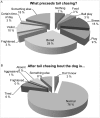Environmental effects on compulsive tail chasing in dogs
- PMID: 22844513
- PMCID: PMC3406045
- DOI: 10.1371/journal.pone.0041684
Environmental effects on compulsive tail chasing in dogs
Abstract
Obsessive Compulsive Disorder (OCD) is a neuropsychiatric disorder observed both in humans and animals. Examples of Canine Compulsive Disorder (CD) include excessive tail chasing (TC), light/shadow chasing and flank sucking. We performed a questionnaire survey to investigate the characteristics of compulsive (TC) and its possible associations with environmental correlates and personality in a pet population of 368 dogs from four dog breeds. We observed an early onset of TC at 3-6 months of age and a large variation in TC frequency in all breeds, with an overrepresentation of milder cases. Almost half of the TC dogs showed lowered responsiveness during bouts and displayed also other types of compulsions more often than the controls. Interestingly, dogs that received dietary supplements, especially vitamins and minerals, expressed less TC compared to dogs that did not receive any supplements. Neutered females had less TC, suggesting an influence of ovarian hormones on TC. Tail chasers were shyer and had separated earlier from their mothers than the controls. Finally, our genetic study did not find an association between TC and CDH2, a locus previously associated with the canine flank sucking compulsion. In conclusion, the early-onset and the variable nature of the repetitive behaviour, which is affected by environmental factors such as micronutrients, neutering and maternal care, share several similar components between canine and human compulsions and supports canine TC as a model for human OCD.
Conflict of interest statement
Figures







References
-
- Mataix-Cols D, do Rosario M, Leckman J. A multidimensional model of obsessive-compulsive disorder. Am J Psychiatry. 2005;162:228–238. - PubMed
-
- Ayuso-Mateos JL. Global burden of obsessive-compulsive disorder in the year 2000. World Health Organization. 2006. Available: http://www.who.int/healthinfo/statistics/bod_obsessivecompulsive.pdf. Accessed 2012 Jul 2.
-
- Walitza S, Wendland JR, Gruenblatt E, Warnke A, Sontag TA, et al. Genetics of early-onset obsessive-compulsive disorder. Eur Child Adolesc Psychiatry. 2010;19:227–35. - PubMed
-
- Franklin M, Foa E. Treatment of obsessive compulsive disorder. Annu Rev Clin Psycol. 2011;7:229–243. - PubMed
Publication types
MeSH terms
LinkOut - more resources
Full Text Sources
Other Literature Sources
Research Materials

